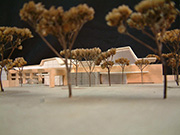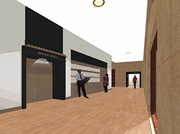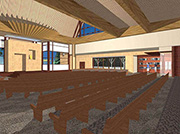
Steve J. Horna
construction management
Shaare Tefila Congregation
Olney, Montgomery County, Maryland
| home |
| steve j horna |
| building statistics |
| thesis abstract |
| technical assignments |
| thesis research |
| thesis proposal |
| presentation |
| reflection |
| final report |
| Senior thesis e-Studio |
User Note:Note: While great efforts have been taken to provide accurate and complete info-rmation on the pages of CPEP, please be aware that the information contained here with is considered a work-in-progress for this thesis project. Modifications and changes related to the original building designs and construction methodologies for this senior thesis project are solely the interpretation of Steve Horna. Changes and discrepancies in no way imply that the original design contained errors or wasflawed. Differing assump- tions, code references, requirements, and methodologies have been incorporated into this thesis project; therefore, investigation results may vary from the original design. |
Building Statistics |
|
building Shaare Tefila Synagouge, Montgomery County, MD
building occupant Shaare Tefila Congregation
occupancy Mixed use;
A-3 Assembly; I-4 Institutional
building size
43,000 sf (Proposed Building Gross Area) 12,665 sf (Additional Gross Area)
45,665 sf (Total Gross Area)
number of stories 2 stories (Proposed) 3 stories (Allowable)
project team
Owner Shaare Tefila Congregation
Architect WCMRP, inc
General Contractor Forrester Construction Company
Civil Engineer A. Morton Thomas and Associates, Inc.
Structural Engineer The Watkins Partnership
Mechanical Engineer Weigand Associates, Inc.
date of construction September 24th, 2007-October 24th, 2008
cost information $10.79 million (Building Cost)
project delivery method Guaranteed Max Price
architecture
architecture
The building will serve as a new and more spacious home to the members of Montgomery
county's Jewish community. Major Features include a 90 seat chapet for daily prayer,
Khuddish room and Social Hall for special events, a functioning Youth Activiey Center,
Nursery school, and administrative
major national model code Referencing 2003 IBC/ 2006 NFPA Life Safety
zoning R200
historical requirements Montgomery County Tree Saving Agrreement
building envelope
PVC roof system; Fiber Cement Panel system, Finshed CMU (Exterior Walls);
Ceramic tile (2 types); Coated copper Coping, Pre-Finished Metal Coping, Normal and
Patterned Glass
construction
A major challenge for construction of Shaare Tefila Congregation is the site work
and demoltion. Clearing the 4 acre property includes demolition of an existing
residential home, garage and green house, as well as selected trees and large
equipment.
The
challenge and source of delay was the environmental hazards of
asbestos and
lead lined
paint. Strict adherenaces to tree protection and safety laws
also required
additional care
and notice.
structural system
The structural system is composed of structural steel and structural masonry.
Typical
interior steel beam size is W16x31. Typical exterior steel column size is
W8 x 28. The foundation is shallow with strip footings. Composite slabs are steel
and cast-in-place
concrete with a thickness of 4-1/2".
The roof system is composed of glue-laminated wood beams and is supported by
steel
22 gage steel framing.
mechanical system
The mechanical room is located on the
lower level and is approximately 1800 SF.
Standard duct size is 4"Φ-8"Φ, for 400 lbs/linear foot, and 10"Φ-12"Φ, for 800 lbs/linear
foot. Corrugated duct size is 14"Φ-36"Φ for 2000 lbs/linear foot
Two rooftop Air Handling Units provide air distribution for 8 ventilation zones.
Occupancy sensors in each of the 8 zones curbs energy overconsumption. Each
zone
is seperated based on capacity and usage.
electrical system
The electrical systems which supports typical office use and school time use as
well as
speaker and data systems for gathering spaces is a service load of 2500 Amps.
All work
is to comply with requirements of the NEC, NFPA, BOCA, IBC and
Montgomery
county codes. All fixtures are to be connected to the Emergency panel
and will be
powered by the generator (located in the mechanical room) in case
the building loses
normal power. Emergency lighting and battery pack will also
be connected to standby
generator.
lighting system
Typical lighting varies based on room and function, but include: downward,
decorative, wall-mounted, recessed, pendant, projection lens, and surface mounted
fixtures. Area lourescent lighting is used for most classrooms. Dimming ballasts
for hall corridors and chapel are soft lighting systems. The classrooms on the
lower
level will have dual level switching to toggle
the outer and inner lights.
fire protection
Shaare Tefila Congregation is covered entirely by a wet pipe sprinkler system.
The
automatic sprinkler system is intended for design-build installation and
will be
installed
by the fire protection contractor. Standpipes are used in both
stairwells and
pressure
is
controlled by a fire pump. The interior walls have a
2 hour fire-rating.
All sprinklers and alarms comply with codes
for
Montgomery
county, NFPA as well
as ADA requirements.
transportation
The hydraulic elevator servces both floors of the synagogue and is located in the
north-west section, closer to the kitchen. The elevator is specified as a passenger
elevator
however it
will be used as a service and loading elevator from the loading
dock to the
kitchen and
to the upper floor. The conveyance system complies with
ADA requirements
as well as
NFPA code and elevator codes for Montgomery
county. Stairwells are located on the north-west corner as well as the south-west
corner.
telecommunication
The chapel and ceremony halls in the synagogue will be installed with a full music
and
speaker system to be provided by the owner. The office and administrative
rooms
will
have data/fax and voice telecommunication systems installed and owner
provided.
geothermal system
Since there is no outside water source to the site, geothermal wells are being
implemented
into the building's mechanical system. The wells will tie into the
mechanical system and then be used to circulate the building's water supple. Using
the earth's natural heat as a energy heating and cooling source, the water supply will
be controlled based on season and usage. This systems is a high initial cost, however
the cost and usage over the life of the building will result in utilities savings.


